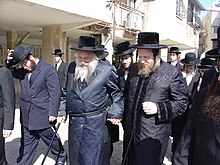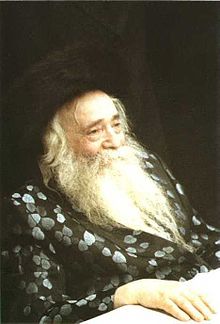| Revision as of 11:37, 19 December 2019 editPPEMES (talk | contribs)Extended confirmed users44,744 edits →External links← Previous edit | Revision as of 19:19, 28 July 2020 edit undoIra Leviton (talk | contribs)Extended confirmed users333,097 edits Added transliteration tags so that non-English words aren't detected as typos by spellcheckers like Misplaced Pages:Typo Team/moss. Please see Template:Lang#Rationale.Next edit → | ||
| Line 2: | Line 2: | ||
| ] ] wearing a ''Tish Bekishe'']] | ] ] wearing a ''Tish Bekishe'']] | ||
| A '''bekishe''', '''bekeshe''' or '''beketche |
A '''bekishe''', '''bekeshe''' or '''{{transl|yid|italic=no|beketche}} ({{lang-yi|בעקעטשע}} or '''בעקישע'''), is a type of ], usually made of black ] or ], worn by ], and by some non-Hasidic ] Jews.<ref>{{cite web|url=https://www.nytimes.com/2005/10/16/arts/design/16jain.html|title=Two Brothers, Two Paths, One Photo Album|first=Johanna|last=Jainchill|website=nytimes.com}}</ref> | ||
| The bekishe is worn mainly on ] and ]s, or at weddings and other such events. During the week, it is customary to wear a ], made of wool or polyester, looking like a regular double-breasted suit, only longer. Hassidic rabbis who wear a bekishe during the week will wear a more ornate version for Shabbos, often lined with velvet or some color other than or in addition to black. | The bekishe is worn mainly on ] and ]s, or at weddings and other such events. During the week, it is customary to wear a ], made of wool or polyester, looking like a regular double-breasted suit, only longer. Hassidic rabbis who wear a bekishe during the week will wear a more ornate version for Shabbos, often lined with velvet or some color other than or in addition to black. | ||
| There are two main types of bekishe. The glatt (plain, lit. smooth) bekishe is solid colored, and is usually worn for ] and Saturday ]. For Shabbos meals, the patterned bekishe, also known as a tish bekishe (table Bekishe), is worn. The tish bekishe is also worn by some during the Shabbos ] and the night after Shabbos. Both can be made of silk, although nowadays it is usually polyester. Some non-Hassidic Orthodox Jews wear a tish bekishe at home during the Shabbos meals. Many Hassidic Rebbes, mainly of Hungarian lineage, wear tish bekishes with various colors, usually either, blue, silver, often with black. | There are two main types of bekishe. The glatt (plain, lit. smooth) bekishe is solid colored, and is usually worn for ] and Saturday ]. For Shabbos meals, the patterned bekishe, also known as a tish bekishe (table Bekishe), is worn. The tish bekishe is also worn by some during the Shabbos ] and the night after Shabbos. Both can be made of silk, although nowadays it is usually polyester. Some non-Hassidic Orthodox Jews wear a tish bekishe at home during the Shabbos meals. Many Hassidic Rebbes, mainly of Hungarian lineage, wear {{transl|yid|italic=no|tish bekishes}} with various colors, usually either, blue, silver, often with black. | ||
| The bekishe is black. The gold and blue striped garments worn by Yerushalmi Haredim such as ], ], ], ], ], ], ], and many but not all in ], as well as other non-affiliated Yerushalmi Haredim such as the ] are called ]s. Those members of these movements centred in Jerusalem or one of the Jerusalem-affiliated suburbs such as ], ] or ] wear these gold coats. Those who live further away, for example in ], ] or outside of E. Israel, usually wear black bekishes like most other Hasidim, as do some of those who live in Jerusalem. The gold ] is generally worn after marriage; before marriage, either a black bekishe or weekday-style clothing is worn on days when a bekishe is usually worn. Some of those who wear the gold bekishe switch to black on Shabbos afternoon before ]; this is seen in, for example, Dushinsky and with many of the Prushim. | The bekishe is black. The gold and blue striped garments worn by Yerushalmi Haredim such as ], ], ], ], ], ], ], and many but not all in ], as well as other non-affiliated Yerushalmi Haredim such as the ] are called ]s. Those members of these movements centred in Jerusalem or one of the Jerusalem-affiliated suburbs such as ], ] or ] wear these gold coats. Those who live further away, for example in ], ] or outside of E. Israel, usually wear black {{transl|yid|italic=no|bekishes}} like most other Hasidim, as do some of those who live in Jerusalem. The gold ] is generally worn after marriage; before marriage, either a black bekishe or weekday-style clothing is worn on days when a bekishe is usually worn. Some of those who wear the gold bekishe switch to black on Shabbos afternoon before ]; this is seen in, for example, Dushinsky and with many of the Prushim. | ||
| ].]] | ].]] | ||
| Line 14: | Line 14: | ||
| Married ] hasidim wear a long black kapoteh (]) instead of a bekishe. The kapoteh or frak, besides its unique waist seam construction, has four buttons in the front (as opposed to six on the front of a bekishe), as well as slit in the back, which is lacking on the bekishe. The kapoteh can be made of either wool or silk. | Married ] hasidim wear a long black kapoteh (]) instead of a bekishe. The kapoteh or frak, besides its unique waist seam construction, has four buttons in the front (as opposed to six on the front of a bekishe), as well as slit in the back, which is lacking on the bekishe. The kapoteh can be made of either wool or silk. | ||
| Many Hassidic Rebbes wear samet (velvet) or strohkes (velvet piping), symbolizing ], on the bekeshe. | Many Hassidic Rebbes wear {{transl|yid|italic=no|samet}} (velvet) or {{transl|yid|italic=no|strohkes}} (velvet piping), symbolizing ], on the bekeshe. | ||
| ==History== | ==History== | ||
| The bekishe derives from the Hungarian |
The bekishe derives from the Hungarian {{lang|hun|bekes}} circa the 16th century, a sort of fur-lined coat with a collar, fastened by clasps. The bekes was often richly decorated, sometimes with ].<ref>{{cite web |last1=Goldberg-Mulkiewicz |first1=Olga |title=Dress |url=http://www.yivoencyclopedia.org/article.aspx/Dress |website=YIVO Encyclopedia of Jews in Eastern Europe |accessdate=26 July 2018}}</ref> | ||
| ==References== | ==References== | ||
Revision as of 19:19, 28 July 2020


A bekishe, bekeshe or Error: {{Transliteration}}: unrecognized language / script code: yid (help) (Template:Lang-yi or בעקישע), is a type of frock coat, usually made of black silk or polyester, worn by Hasidic Jews, and by some non-Hasidic Haredi Jews.
The bekishe is worn mainly on Shabbos and Jewish holidays, or at weddings and other such events. During the week, it is customary to wear a rekel, made of wool or polyester, looking like a regular double-breasted suit, only longer. Hassidic rabbis who wear a bekishe during the week will wear a more ornate version for Shabbos, often lined with velvet or some color other than or in addition to black.
There are two main types of bekishe. The glatt (plain, lit. smooth) bekishe is solid colored, and is usually worn for Friday night and Saturday morning prayers. For Shabbos meals, the patterned bekishe, also known as a tish bekishe (table Bekishe), is worn. The tish bekishe is also worn by some during the Shabbos afternoon prayer service and the night after Shabbos. Both can be made of silk, although nowadays it is usually polyester. Some non-Hassidic Orthodox Jews wear a tish bekishe at home during the Shabbos meals. Many Hassidic Rebbes, mainly of Hungarian lineage, wear Error: {{Transliteration}}: unrecognized language / script code: yid (help) with various colors, usually either, blue, silver, often with black.
The bekishe is black. The gold and blue striped garments worn by Yerushalmi Haredim such as Toldos Aharon, Toldos Avrohom Yitzchok, Dushinsky, Neturei Karta, Shomer Emunim, Pinsk-Karlin, Karlin-Stolin, and many but not all in Breslov, as well as other non-affiliated Yerushalmi Haredim such as the Perushim are called kaftans. Those members of these movements centred in Jerusalem or one of the Jerusalem-affiliated suburbs such as Beitar Illit, Ramat Beit Shemesh or Modi'in Illit wear these gold coats. Those who live further away, for example in Bnei Brak, Ashdod or outside of E. Israel, usually wear black Error: {{Transliteration}}: unrecognized language / script code: yid (help) like most other Hasidim, as do some of those who live in Jerusalem. The gold kaftan is generally worn after marriage; before marriage, either a black bekishe or weekday-style clothing is worn on days when a bekishe is usually worn. Some of those who wear the gold bekishe switch to black on Shabbos afternoon before Mincha; this is seen in, for example, Dushinsky and with many of the Prushim.

Married Chabad hasidim wear a long black kapoteh (frock coat) instead of a bekishe. The kapoteh or frak, besides its unique waist seam construction, has four buttons in the front (as opposed to six on the front of a bekishe), as well as slit in the back, which is lacking on the bekishe. The kapoteh can be made of either wool or silk.
Many Hassidic Rebbes wear Error: {{Transliteration}}: unrecognized language / script code: yid (help) (velvet) or Error: {{Transliteration}}: unrecognized language / script code: yid (help) (velvet piping), symbolizing tefillin, on the bekeshe.
History
The bekishe derives from the Hungarian bekescode: hun promoted to code: hu circa the 16th century, a sort of fur-lined coat with a collar, fastened by clasps. The bekes was often richly decorated, sometimes with galloon.
References
- Jainchill, Johanna. "Two Brothers, Two Paths, One Photo Album". nytimes.com.
- Goldberg-Mulkiewicz, Olga. "Dress". YIVO Encyclopedia of Jews in Eastern Europe. Retrieved 26 July 2018.
External links
| Clothing | |||||||||
|---|---|---|---|---|---|---|---|---|---|
| Headwear | |||||||||
| Neckwear | |||||||||
| Underwear and lingerie |
| ||||||||
| Tops | |||||||||
| Bottoms |
| ||||||||
| Full-Body Wear |
| ||||||||
| Coats and outerwear |
| ||||||||
| Nightwear | |||||||||
| Swimwear | |||||||||
| Legwear | |||||||||
| Footwear | |||||||||
| Accessories |
| ||||||||
| Dress codes |
| ||||||||
| Related | |||||||||